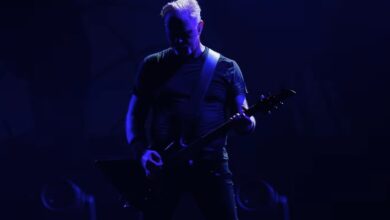Echoes of Silence: Why Some Fans Find the Royal Marines’ Rendition More Moving Than Disturbed’s
At the 2020 Mountbatten Festival of Music, the Royal Albert Hall dimmed into shadow before a clarinetist stepped into a solitary spotlight. The hall, packed with thousands, seemed to draw a collective breath as the first phrases of “The Sound of Silence” floated outward. The hush was total, every ear tuned to a melody that carried both memory and mystery, and the atmosphere felt charged with anticipation.
This performance leaned into grandeur, but its lineage reached forward as much as backward. While the song first emerged in the hushed folk cafes of the 1960s, many in the audience could not help but recall Disturbed’s searing 2015 interpretation, which reshaped the piece for a new generation. Against that backdrop, the Marines’ woodwinds offered restraint, almost as if answering the intensity of Disturbed’s guttural force with elegance and control.
As strings slid into the arrangement, the hall shifted. Instead of relying on raw vocal anguish, the ensemble built a vast, cinematic soundscape, punctuated by brass chords that rose like cathedral bells. This orchestral layering created a contrast that highlighted the difference in approach: Disturbed’s version stuns by overwhelming, while the Marines’ captivated through balance and poise.
Precision has long defined military bands, yet in this piece, precision carried emotion rather than rigidity. Each rest felt deliberate, each silence more profound than the note preceding it. For fans who loved Disturbed’s darker intensity, this offered another form of catharsis—less primal but no less stirring, a kind of reverence born from discipline rather than raw pain.
Part of the performance’s impact lies in history. Royal Marines musicians are trained not only as artists but as soldiers, many of whom once served on naval vessels where they provided both morale and medical care. That legacy of service infused the piece with gravity, reminding listeners that music and sacrifice have long intertwined. To some ears, it was as haunting as David Draiman’s growl—different tools, same resonance.
The Mountbatten Festival itself added further layers. Dedicated to naval heritage and service charities, the event gave the music weight beyond aesthetics. When those opening lines echoed, many thought not only of Simon & Garfunkel but also of the soldiers and families whose stories remain unspoken. Where Disturbed’s performance often resonates as a meditation on personal struggle, the Marines reframed it as a collective elegy.
Technology amplified this resonance. Clips from the evening spread rapidly online, drawing comparisons between this stately orchestral version and Disturbed’s viral powerhouse. Some fans commented that they preferred the Marines’ interpretation precisely because it avoided the sense of spectacle—its power lay in stillness rather than storm, and that difference spoke to those seeking serenity instead of confrontation.
The Corps of Drums injected rhythm at the midpoint, snare rolls echoing like a heartbeat. Yet even then, the piece avoided tipping into bombast. Where Disturbed captured attention through explosive crescendos, the Marines demonstrated how subtle crescendos, grounded in restraint, could be just as commanding. Both versions revealed different faces of silence: one filled with rage, the other with contemplation.
Audience reactions testified to this polarity. Older listeners compared the performance to solemn wartime broadcasts, while younger fans linked it to the emotional intensity of Disturbed’s cover. Rather than choosing one over the other, many admired how the Marines distilled that same emotional core into something orchestral, proving the song’s adaptability across genres and generations.
The acoustics of Royal Albert Hall magnified every nuance. A triangle’s chime, barely audible at first, rippled into the rafters like an invisible choir. These details explained why some fans favored this version: it didn’t just translate the song into orchestral form; it made silence itself an instrument, turning absence into presence. Disturbed had filled silence with thunder; the Marines filled it with echoes.
Irony was not lost on anyone. A song once used by protesters against war now carried force inside a military gala. Yet far from contradiction, the Marines’ interpretation became dialogue. Just as Disturbed gave voice to modern alienation, the band here embodied remembrance—soldiers acknowledging the unspoken cost of service. Both reimaginings proved that music remains a mirror, reflecting whoever dares to hold it up.
Beyond concerts, the Marines carry this repertoire to schools, ceremonies, and humanitarian missions. “The Sound of Silence” has become a centerpiece, often requested in contexts where words fail—much like Disturbed’s cover has become an anthem for listeners wrestling with isolation. That parallel highlights why fans are divided: some want the catharsis of a scream, others the solace of stillness.
When the final note dissolved into silence, the hall erupted in thunderous applause. Veterans and civilians alike rose, some in tears, others cheering with unrestrained gratitude. Online, debates continued—Disturbed’s raw power versus the Marines’ solemn majesty—but beneath the comparisons, one truth endured. This song, in any form, carries a universality few works achieve.
Both interpretations leave indelible marks. Disturbed’s cover speaks to the individual wrestling with inner darkness, while the Marines’ version elevates silence into collective remembrance. Together, they prove that great songs are not fixed—they live, transform, and find new voices in unexpected places. And perhaps that is why “The Sound of Silence” continues to resonate: because whether shouted, whispered, or orchestrated, it tells us something we cannot forget.





